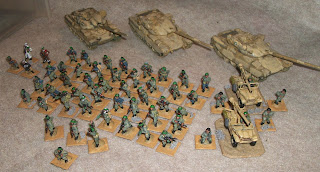This past weekend, the three former owners of Iron Ivan Games, along with the author of the IIG Berlin book and his own Altar of Freedom system, met for some Iron Ivan themed gaming.
Both games featured the USMC. I'll discuss the 2nd game first, a more-or-less thrown together game representing bunker clearing late in the battle for Saipan in 1944. We of course were using Disposable Heroes, and the Red Sun Red Death PTO supplement.
The Japanese had their forces spread along a series of fortifications and natural features. The player was allowed to keep stuff off until it activated, and could dictate how many Japanese units activated each turn. In this way, the Marines never knew for sure if more Japanese would show up, or where they would show up at.
[The Japanese and Marine infantry were all Brigade Games 28mm, the 37mm ATG and Ha-Go were from Company B]
The Marines attacked with a couple of battle-attritioned infantry squads, supported by flamethrower and bazookas. They also had a 37mm ATG and a .30 HMG. The Japanese defenders included battle-attritioned infantry teams, Typ 89 mortar, an HMG, a spider hole with LMG, 70mm IG, and Ha-Go tankette.
The 37mm failed to knock out a heavy log bunker, but a Marine bazooka team got the job done. Japanese infantry popped up in a trench line, and were quickly whittled away.
The Marines on the right flank moved past the burning bunker (expecting to take fire at any time), eventually arriving in line of sight to the 70mm IG which had been lobbing speculative shots up until then. The 37mm ATG was knocked out by the Ha-Go (an unexpected development).
At this point, the last survivor of a Japanese team on the ridge failed his morale, which resulted in a roll on my ever popular Japanese Reaction Table..... the result was a bonus 9" Banzai move....
... and since it was a bonus move, the model was able to move on its own a further 9" towards the nearest Marines who took snap fire at the model...
... which failed to bring him down, BUT did cause another morale test, which the Japanese model failed, resulting in an additional 9" bonus movement, bringing the model into close combat....
... and he was able to take a Marine with him! As one player said, " man, that guy is fast!"
The Marines on the right flank moved up after taking fire from the 70mm IG, and tried to put a flamethrower into action... they missed, but the morale test was failed by the IG crew, who also gained a bonus 9" move (we were rolling on the Despaired table, which is mostly seppuku and banzai)...
... which moved them into close combat. Here again the Japanese scored kills in melee before being eliminated.
The Marines had suffered some casualties, but the Japanese were all but eliminated. The scenario was a little off balance, we should have had a few less USMC assets (I was a Marine player, so not sour grapes on my part!), or a couple more Japanese units. The Japanese requested a couple more automatic weapons next time :) Still, this was a very fast moving game, maybe about an hour of play after we set up, and we all had fun.
Ever since I wrote Red Sun Red Death, I have met many gamers who love those Japanese reaction tables.... we do too. Its not common to see so many bonus banzai moves in a single game, but when you do, its very exciting for both sides.
The first game we played that day was a Marines vs Druze Militia in Beirut 1982, and "what if" scenario where the Marines were allowed to clean house. The good Doc chronicled this game on his own blog Doctor Merkury's Lab.
The table looked great, but right from the start the two Marine players (including me) were botching the job.
I moved the M60 forward, and was immediately taking fire from the dug in T-34/85, a roof top 57mm RR team, and an RPG. I managed to miss the T-34 twice before retreating. We used smoke (the only thing we seemed to do right), but we were losing Marines almost as fast as we were taking out Militia.
The Marine M47 Dragon team made short work of the T-34/85, but it was too little too late.
The Marines tried to flank from the left, but it just was not working. Smoke was deployed to cover the advance of the LVTP-7 (amtrac!), but it was no use. We conceded the game before taking further casualties.
I have no excuse. Instead of house hopping, I stuck to the streets, and lost in the long range exchanges. But it was a fun game, and an unusual gaming period.
Thanks to the other IIG alumni for rolling dice with me!
Chalfant





















































